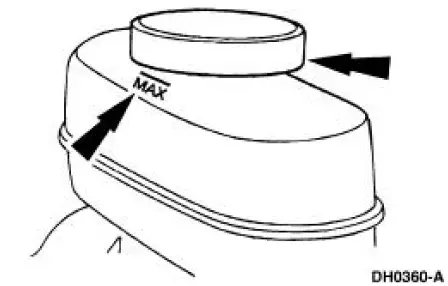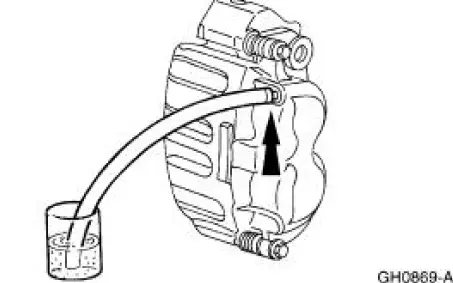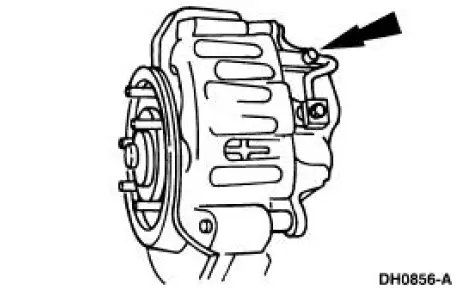Ford Mustang (1999-2004) Service Manual: Manual
WARNING: Brake fluid contains polyglycol ethers and polyglycols. Avoid contact with eyes. Wash hands thoroughly after handling. If brake fluid contacts eyes, flush eyes with running water for 15 minutes. Get medical attention if irritation persists. If taken internally, drink water and induce vomiting. Get medical attention immediately.
CAUTION: Do not allow the brake master cylinder reservoir to run dry during the bleeding operation. Keep the brake master cylinder reservoir filled with the specified brake fluid. Never reuse the brake fluid that has been drained from the hydraulic system.
CAUTION: Brake fluid is harmful to painted and plastic surfaces. If brake fluid is spilled onto a painted or plastic surface, immediately wash it with water.
NOTE: When any part of the hydraulic system has been disconnected for repair or installation of new components, air can get into the system and cause spongy brake pedal action. This requires bleeding of the hydraulic system after it has been correctly connected. The hydraulic system can be bled manually or with pressure bleeding equipment.
1. Clean all dirt from and remove the brake master cylinder filler cap and fill the brake master cylinder reservoir with the specified brake fluid.

2. Place a box end wrench on the RH rear bleeder screw. Attach a rubber drain tube to the RH rear bleeder screw and submerge the free end of the tube in a container partially filled with clean brake fluid.

3. Have an assistant pump the brake pedal and then hold firm pressure on the brake pedal.
4. Loosen the RH rear bleeder screw until a stream of brake fluid comes out. While the assistant maintains pressure on the brake pedal, tighten the RH rear bleeder screw.
- Repeat until clear, bubble-free fluid comes out.
- Refill the brake master cylinder reservoir as necessary.
5. Tighten the RH rear bleeder screw.

6. Repeat Steps 2, 3, 4 and 5 for the LH rear bleeder screw.
7. Place a box end wrench on the RH front disc brake caliper bleeder screw. Attach a rubber drain tube to the RH front disc brake caliper bleeder screw, and submerge the free end of the tube in a container partially filled with clean brake fluid.

8. Have an assistant pump the brake pedal and then hold firm pressure on the brake pedal.
9. Loosen the RH front disc brake caliper bleeder screw until a stream of brake fluid comes out.
While the assistant maintains pressure on the brake pedal, tighten the RH front disc brake caliper bleeder screw.
- Repeat until clear, bubble-free fluid comes out.
- Refill the brake master cylinder reservoir as necessary.
10. Tighten the RH front disc brake caliper bleeder screw. For additional information, refer to Specifications in this section.

11. Repeat Steps 7, 8, 9 and 10 for the LH front disc brake caliper bleeder screw.
 Pressure
Pressure
1. Clean all dirt from and remove the brake master cylinder filler
cap and fill the brake master
cylinder reservoir with the specified brake fluid.
2. NOTE: Master cylinder pressure bleeder ada ...
Other materials:
Door Speaker - Upper
Removal and Installation
1. Remove the front door trim panels (239420). For additional
information, refer to Section
2. Remove the upper speaker access cover.
3. Remove the upper speaker housing.
1. Remove the screw.
2. Remove the upper spea ...
Cooling System Draining, Filling and Bleeding
Material
Item
Specification
Motorcraft Premium Gold
Engine Coolant
VC-7-A (in Oregon VC-7-B)
(yellow color)
WSS-M97B51-
A1
Draining
WARNING: Never remove the pressure relief cap while the engine is
operating or when the
cooling syst ...
Installation
1. NOTE: LH shown; RH similar.
Install the camshafts.
Lubricate the camshafts with clean engine oil.
2. Install the camshaft bearing cap assemblies and tighten the bolts in the
sequence shown.
3. Install the bolts.
4. CAUTION: Timing marks must be a ...

